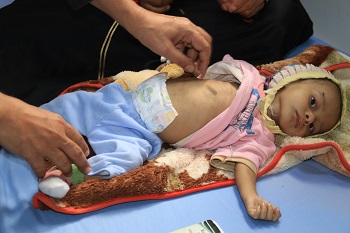From cholera in Yemen to attacks on hospitals in Syria, conflict threatens lives of over 24 million children in the Middle East and North Africa
Violence and conflict in the Middle East and North Africa have put in jeopardy the health of 24 million children in Yemen, Syria, the Gaza Strip, Iraq, Libya and Sudan. Damage to health infrastructure is depriving children of essential health care. Water and sanitation services have been compromised, causing waterborne diseases to spread while preventative health care and nutritious food are insufficient to meet children’s needs.

A boy suffering from severe acute malnutrition acute at Al-Thawra Hospital, Hodeidah, Yemen, Monday 6 March 2017.
“Violence is crippling health systems in conflict-affected countries and threatens children’s very survival,” said Geert Cappelaere, UNICEF Regional Director for the Middle East and North Africa. “Beyond the bombs, bullets and explosions, countless children are dying in silence from diseases that could easily be prevented and treated.”
In Yemen (9.6 million children in need):
• The two-year conflict has pushed Yemen to the brink of famine and plunged the country into one of the world’s worst humanitarian crises, with widespread severe acute malnutrition among children,
• Salaries for health care and sanitation workers haven’t been paid for more than seven months,
• Contaminated water sources, untreated sewage and uncollected garbage, sparked a cholera outbreak with 323 associated deaths in the last month alone.
• Two thirds of the population use unsafe water,
• Health care facilities are struggling to cope with the volume of patients - many of them children - amid shortages of medical supplies and clean water.
In Syria (5.8 million children in need):
• More than 2 million children live under siege and in hard-to-reach areas with little to no humanitarian aid. Surgical and other lifesaving supplies are regularly removed from the few convoys that are allowed into these areas,
• Many children do not have access to life-saving vaccinations and those who fall ill or are injured struggle to get treatment,
• Attacks on hospitals and other health facilities have become commonplace – almost 20 per month between January and March this year. The few hospitals that are still operational function with limited staff and services.
• The threat of polio – such as the outbreak that hit Syria in 2013 – still looms.
In the Gaza Strip (1 million children in need):
• Since the main power plant shut down on 16 April, power cuts have reduced water supply to 40 litres per person per day, less than half of the minimum international standard,
• Wastewater treatment plants now deposit 100,000 cubic metres of raw sewage into the sea daily, increasing the risk of waterborne diseases,
• 14 public hospitals are operating for critical services only.
In Iraq (5.1 million children in need):
• Water supplies in camps for the displaced around Mosul are stretched to the limit with new families arriving daily, many with malnourished children,
• The widespread use of unsafe well water, with the accumulation of solid waste in and around Mosul, are exposing children to the risk of waterborne diseases,
• UNICEF estimates that 85,000 children are trapped in western Mosul, cut off from humanitarian aid for the past seven months and with limited access to medical care.
In Libya (450,000 children in need):
• Last year, Libya recorded 20 attacks against health facilities, second only to Syria,
• Immunization programmes have been facing challenges since the conflict erupted in 2011, with suspected measles cases reported among young children,
• Without new funding, over 1.3 million children won’t be vaccinated against measles or rubella, putting these children – and others in the country – at risk of highly contagious and potentially fatal diseases.
In Sudan (2.3 million children in need):
• Over 8,000 cases of acute watery diarrhoea have been recorded in just eight months in conflict-affected areas including those hosting large numbers of refugees from South Sudan,
• Cases of acute watery diarrhoea are set to rise rapidly once the rainy season begins in June.
Across these countries, UNICEF and its partners are working around the clock to provide vulnerable children with safe water, water treatment, medical and nutrition supplies to prevent the total collapse of essential health and water systems. But as conflicts continue, and amid a shrinking humanitarian space, challenges to reach all vulnerable children with lifesaving assistance are growing.
“When children can’t access healthcare or improved nutrition, when they drink contaminated water, when they live surrounded by waste with no sanitation, they become ill and some die as a result,” said Cappelaere. “There is very little standing between them and life-threatening illness, especially when humanitarian access is denied.”
UNICEF is appealing for children’s needs to be prioritized in all conflict-affected countries through:
• Unconditional and sustained access to all children in need for UNICEF and other partners to deliver humanitarian assistance and supplies, including lifesaving medical items and vaccination, water purification material and waste treatment.
• Parties to conflicts should put an immediate end to attacks on health facilities. Health facilities and civilian infrastructure should be protected at all times.
• Urgent funding for the health, nutrition and WASH sectors. UNICEF received only one third of its 2017 funding requirements for health, nutrition and water and sanitation in these countries.
Source:United Nations Children's Fund
- 327 reads
Human Rights
Ringing FOWPAL’s Peace Bell for the World:Nobel Peace Prize Laureates’ Visions and Actions

Protecting the World’s Cultural Diversity for a Sustainable Future

The Peace Bell Resonates at the 27th Eurasian Economic Summit

Declaration of World Day of the Power of Hope Endorsed by People in 158 Nations

Puppet Show I International Friendship Day 2020

